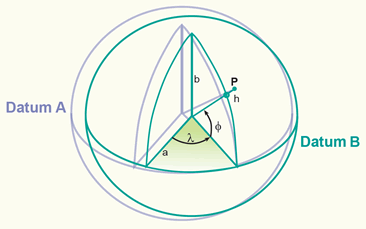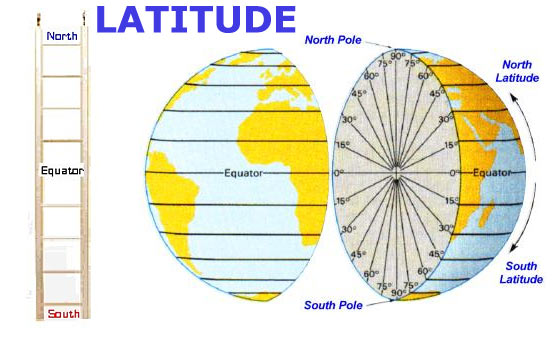Coordinate Systems
Datum
Lat / Long
We all know the basics of coordinate systems, and why they're important. They allow us to identify specific locations on the planet, and they also let us plot them into a map. I'll briefly go over Latitude and Longitude, and hopefully do UTM in a followup post shortly.
But first!
MAP DATUM
Extremely simplified down, you can think of the 'map datum' as the mathematical model that describes the size and shape of the planet. I believe we can all agree that the planet is *roughly* spherical. If you have a balloon and change the amount of air in it the points on the surface will move. If you change the model of the planet with a coordinate grid on it, than the various coordinates laid on top if it are going to change in relation. This is called datum shift, and *must* be accounted for if you're working between datums. The two most common map datums in use are NAD27, and WGS84.

NAD 27 (North American Datum 1927) was established in *gasp* 1927! It's based of the Clarke Ellipsoid of the planet built in 1866. All in all, for being calculated out in 1866 it was remarkably accurate! NAD27 uses an origin point in Kansas, designed to mitigate errors in the model through North America. This is the "default" datum for oldschool USGS quads, although ones with a more recent revision/print date may have 'compensation marks' printed on to convert between datums.
WGS84 (World Geodetic System 1984) is obviously much newer. With fancy satellites and a few hundred thousand incredibly accurate measurements it creates a much more accurate model of the planet.
For our practical purposes, there isn't that much of a difference between the two. The caveat being that virtually all modern technology is going to be designed to function in WGS84. Your cellphones, GPS, Google Maps, etc. The whole map datum thing could get incredibly technical, but I guess the important bit is to remember you need to know what your map is in! If your map is printed in NAD27 (like most oldschool 7.5 minute quads) and your GPS / Cellphone is working in WGS84 your coordinates are not going to land where you're expecting them to. For us around here datum shift is really only a couple hundred meters, but that can be quite significant.
Latitude and Longitude
Latitude and Longitude would probably be what most people consider the 'standard' coordinate system. This will be the default in most GPS units, it's what virtually all online mapping sites will use, as well as cellphone pings, etc.
The earth revolves around an axis, we as a people have defined where that axis comes out of the planet as the poles, and arbitrarily decided one as North, and the other as South. Halfway in between we've defined the 'equator' dividing the two. This is a line of latitude that defined by the planet, not by use lowly humans, we just put names on them.
Latitude is further divided radially from the equator North 90° and South 90° This creates concentric 'rings' parallel to the equator, measuring degrees North and South

Longitude is measuring around the planet. These lines converge at the poles, and are furthest apart at the equator. We've decided (arbitrarily) that the 0° mark will be running through Greenwich, England. We like to call that it the Prime Meridian, because it's a fancy name and makes it sound important. Opposite of that is the 180° mark, commonly called the International Date Line, although that's not entirely accurate. The 180° meridian is straight, where the IDL *mostly* follows it, but zigzags around to do things like keep Alaska all in the same day..

Although we've already established that there are 360° in a circle. Coordinates in Lat Long don't like to follow the rules. Latitude is measured 0-90° North/South of the Equator, and Longitude being 0-180° East or West of the Prime Meridian. If we want to get more accurate than that it starts to get tricky... Lat Long is commonly read in one of 3 formats, 1: D°.Decimal Degrees, ie 45.0000°N 122.0000°W 2: D° Minutes'.Decimal Minutes, is 45° 30.000'N 122° 30.000'W or 3: Degrees° Minutes' Seconds"
You can think of Degrees like hours. There are 60 minutes in a Degree, generally designated with a single hash ' and 60 seconds in a minute, with a double hash ". The first D.dddd° is becoming more and more common, you car GPS, cellphones, and most aircraft will be operating in this. It's easier to punch into a computer.
Couple notes to remember if you're actually working on plotting these out on a map. Lat Long as a geographic coordinate system is a series of curved lines, it can be difficult to accurately calculate things like distance, area, and even directions some times. For instance, this satellite orbit is a "straight line" (simplified actually, that particular image takes the rotation of the earth in relation to the satellite out of the equation... )

Lat Longs should always be read Latitude then Longitude. Latitude is measuring Degrees North of the equator, where Longitude is measuring Degrees West of the Prime Meridian. Sometimes it will be expressed as Negative Degrees East, but they're the same thing, it's just easier for most people to work with positive numbers.
Just to make things a bit more confusing... The following sets of coordinates ALL represent the same location (Angels Rest) showing the three different formats of Lat/Long, and the shift caused by switching datums.
WGS84
45.5643°N 122.1533°W
45° 33.858'N 122° 9.198'W
45° 33' 51.48"N 122° 9' 11.8"W
NAD27
45.5645°N 122.1521°W
45° 33.87'N 122° 9.126'W
45° 33' 52.2"N 122° 9' 7.2"W
This isn't generally the technique I would teach for finding coordinates, but it works in a pinch. Please note that the scales for Latitude and Longitude are *different*. One degree in one scale is not the same physical distance as 1 degree in another. In fact, 1° of Longitude is not the same physical distance depending where you are on the planet! In this particular map there are 2" tick marks along the margin, with index lines every 30".
If I'm going to plot, or find coordinates, the first thing I like to do is find the 'box' that they will be in. In this case, finding Angels Rest I know it will fall somewhere between 45° 33' 30" - 45° 34' 00"N and 122° 09' 00" - 122° 09' 30"W. Using the scales on the margins I can build a simple reader/ruler to determine what latitude N of the of 45° 33' 30"N line, and West of the 122° 09' 00"W line I am.
UTM's to come! I just wanted to get that out and posted or I know I probably wouldn't do it before the new year... Please please please ask questions if you have them. The main reason I do these threads is to interact and help out. No response = no fun!
